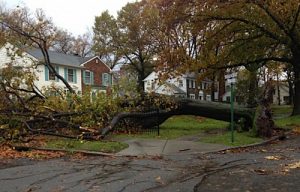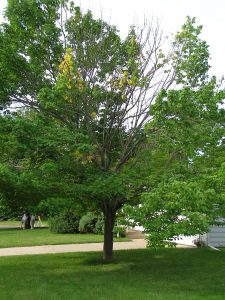Trees: Your Liability and Tree Risk Assessment
By George Graine, Fairfax Master Gardener
“A stricken tree, a living thing, so beautiful, so dignified, so admirable in its potential longevity, is, next to man, perhaps the most touching of wounded objects.” —Edna Ferber
 No doubt if you live in a house you may have a love — hate relationship with trees. You probably also know some of the pros and cons of your trees because you are involved with them daily in your own landscapes, through your neighbor’s experience as well as weather conditions. I attended a class at the 2018 Virginia Cooperative Extension Master Gardener College conference in June on the campus of Virginia Tech. Here Dr. P. Eric Wiseman, Associate Professor of Urban Forestry in the Virginia Tech Dept. of Forest Resources and Environmental Conservation, discussed landscape tree liability and some of the basic practices of risk assessment that we should take into consideration before we regret an untoward event.
No doubt if you live in a house you may have a love — hate relationship with trees. You probably also know some of the pros and cons of your trees because you are involved with them daily in your own landscapes, through your neighbor’s experience as well as weather conditions. I attended a class at the 2018 Virginia Cooperative Extension Master Gardener College conference in June on the campus of Virginia Tech. Here Dr. P. Eric Wiseman, Associate Professor of Urban Forestry in the Virginia Tech Dept. of Forest Resources and Environmental Conservation, discussed landscape tree liability and some of the basic practices of risk assessment that we should take into consideration before we regret an untoward event.
As an aside to Dr. Wiseman’s presentation, we need to recognize that property owners should know their rights (the law) before a squabble ensues over who is at fault, you or your neighbor, over a tree problem. There is a long legal history concerning the development of a new Virginia tree law that came about in 2007. In the main, our legal system is based on what is often referred to as “common law.” These are the laws which came over from England before America was founded. Quoting from lawyer Benny Kass of The Washington Post, who provides a layman’s explanation of the new law: “Under the common law, the land owner owed no duty to those outside his property to correct natural conditions on the [land owner’s] property — even though these conditions might present a hazard to outsiders. My home was my castle and I was the master of that property.” The 1939 Virginia law changed dramatically in 2007 when the Supreme Court of Virginia made a ruling regarding tree liability and damage. The Court held that when a neighbor’s tree causes harm or poses an imminent danger of harm to an adjoining property, the tree owner (neighbor) may be held responsible for the harm.
We know that tree roots and branches have no regard for straight line boundaries of a property line. Without getting into a contentious rancor of fault and associated insurance considerations, homeowners can sue to force a neighbor to cut back branches, tree roots and even require the tree to be taken out. Why not do the neighborly thing and work out the differences and perhaps share the expense when a cost is involved? The reason for the change that overturned the 1939 law is because much of Virginia has changed. The old law was fine when we were a rural state; however, now we have erected houses that are close to one another, townhouses, condominiums, business parks and shopping centers, all the while losing farmland. The Court recognized that the old law “is unsuited to modern urban and suburban life.”
How can we recognize tree liability and assess tree risk, that is, how do we identify and manage hazardous conditions in our trees? There is abundant literature about this subject, and for more detailed information about tree hazards you should consult your homeowner insurance representative. An excellent “tip sheet” from Backyard Woods, “Identify and Manage Hazardous Defects in Your Trees,” is a publication that discusses how to prevent personal injury and property damage. This is a modified version of the publication “How to Recognize Hazardous Defects in Trees.”
Credit Dr. Wiseman’s presentation because most of the highlights noted below should be considered by homeowners who have trees on their property as well as having some knowledge about neighboring trees. To begin, the definition of tree risk is the probability of an event involving trees that have undesired consequences for affected individuals. The probability of risk could be assessed as being anywhere from a low risk to extremely high. Failure risk exists when tree parts are likely to break or fail and likely harm people, property or activities. A tree that poses an unreasonable risk of failure, impact and harm is called a “hazardous tree.” Note that these are legal concepts used in tree risk management that are interrelated:
Duty of Care: The legal obligation to exercise “reasonable care” in protecting others from possible harm.
Standard of Care: The expected behavior of a “reasonably prudent” person in exercising his or her duty of care.
Negligence: Failure to exercise “reasonable care” resulting in harm that was foreseeable.
Liability: Legal responsibility for the consequences of harm that result from negligence.
Many of us have a somewhat general understanding about how and why our trees fail. Some of the reasons are “technical” and some more obvious. A lot has to do with “load.” For example, ice, snow and rain add mass and exert external load on tree parts. Likewise, wind intensifies external load, and we also need to consider how moisture may decrease soil strength and adhesion of roots to soil particles. Dr. Wiseman went into considerable detail to show that in many instances these kinds of problems are probably beyond our limited comprehension. Putting this another way, does the untrained person truly understand tree defects, loading and how trees respond? When is it advisable to call in a tree expert, one who is not only licensed and insured but also holds membership in professional tree societies? As a note of caution, “membership” is not sufficient. At the least, a tree risk assessor should be an International Society of Arboriculture Certified Arborist. Ideally, the assessor should hold the ISA Tree Risk Assessment Qualification. The fact remains that evaluating trees for hazardous defects is a complex process. Obviously, this indicates more than a person who “specializes” in cutting down dead trees and/or removing dead and crossing limbs. Even then one should make sure that the company being hired is licensed and insured before they work on your property. The tree section in a yellow pages telephone book often indicates those companies that have membership in arboriculture organizations. You can also go online and search for tree service. Of course, this does not guarantee individual competence, but it does provide a clue regarding concern about the profession of tree care.

Dying tree branches
The second half of Dr. Wiseman’s presentation was concerned with tree risk assessment. If you are thinking about your trees and feel something is not quite right, then by all means call in a professional arborist. This is when the apt expression, better to be safe than sorry, comes into play. The first step is to assess the target. This includes people, property or activities that could be injured, damaged or disrupted by tree failure. What is the likelihood of a tree impact and the consequence of an impact? Next, assess the site conditions. By observing, this should provide an insight as to the stability and tree exposure to loads (noted above) from wind and precipitation that can lead to the likelihood of tree failure. The third step in understanding tree risk assessment is to consider the tree health, structure and once again loads. Trees fall when mechanical stress exceeds wood strength or root anchorage. This is the likelihood of tree failure. By now you should have gotten the point that tree failure is based on risk assessment, and this is probably not a time for the less knowledgeable homeowner’s DIY assessment. Professionals in the field of arboriculture should be proficient in knowing how to evaluate and rate tree risk. A properly trained person can then determine the likelihood of failure and impact and then note the consequences of failure anywhere from negligible to severe and anything between the two extremes.
Lastly, Dr. Wiseman noted how to understand tree risk mitigation. This means how to reduce tree risk to a reasonable, that is, acceptable level such that the residual risk is tolerable by the tree owner. He referred to target-focused options and tree-focused options. For target-focused options, you can move the target, for example, picnic table and benches; fortify the target of an automobile with a carport or another substantial structure; or restrict activity, for example, under a tree that may be suspect. For tree-focused options, often the most obvious solution is to prune branches or, when appropriate, cable or brace the tree. As a last resort, removing the tree may be disproportionate to the type or severity of the risk. Tree removal is expensive and you have lost a landscape asset — your tree. Also consider performing plant health care by spraying pesticides, inoculating (medicating) the tree and fertilizing to improve tree vitality and response growth.
This is a lot of information to consume, and it should be carefully considered. If we are to continue to enjoy the benefits that trees provide our neighborhoods, then surely we want to have a safe environment and also be able to enjoy the wildlife.
The information in this article is for informational purposes only and is not intended to constitute professional legal advice.
| Resources | |
| • | Identify and Manage Hazardous Defects in Your Trees, Backyard Woods, Missouri Dept of Conservation and Missouri Forestkeepers |
| • | How to Recognize Hazardous Defects in Trees, Northeastern Area State and Private Forestry, USDA Forest Service |
| • | Who’s Responsible When a Tree Falls?, Benny Kass, The Washington Post, Nov 2, 2012 |